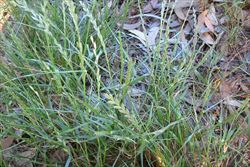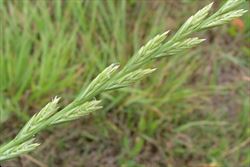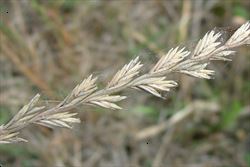Click on images to enlarge

habit (Photo: Sheldon Navie)

stem and leaf blade (Photo: Sheldon Navie)

young seed-head (Photo: Sheldon Navie)

close-up of flower spikelets during flowering (Photo: Sheldon Navie)

mature seed-head (Photo: Sheldon Navie)

close-up of seeds (Photo: Steve Hurst at USDA PLANTS Database)
Scientific Name
Lolium perenne L.
Synonyms
Lolium perenne L. subsp. perenneLolium perenne L. var. cristatum Pers.Lolium perenne L. var. perenne
Family
Gramineae (South Australia)Poaceae (Queensland, New South Wales, the ACT, Victoria, Tasmania, Western Australia and the Northern Territory)
Common Names
English ryegrass, perennial rye grass, perennial rye-grass, perennial ryegrass, ryegrass, rye grass
Origin
Native to Northern Africa (i.e. Algeria, Egypt, Libya, Morocco and Tunisia), the Azores, the Madeira Islands, the Canary Islands, Europe, western Asia, southern Russia, Afghanistan and the Indian sub-continent (i.e. Pakistan and north-western India).
Naturalised Distribution
This species is widely naturalised in southern, central and eastern Australia. It is most widespread and common in Queensland, New South Wales, the ACT, Victoria, Tasmania, the south-eastern and eastern parts of South Australia, and the southern and western parts of Western Australia. Occasionally also naturalised in the southern parts of the Northern Territory, and naturalised on Lord Howe Island and Norfolk Island.
Also naturalised in southern Africa, the Mascarene Islands, New Zealand, the USA, Canada, southern South America, Hawaii and New Caledonia.
Notes
Perennial ryegrass (Lolium perenne) is regarded as an environmental weed in New South Wales, Victoria and Western Australia. This species is grown as a pasture grass and is also deliberately planted in recreation areas in the temperate regions of Australia. It often becomes naturalised in agricultural areas, along roadsides and near habitation, but also invades a wide variety of natural habitats.
Perennial ryegrass (Lolium perenne) is regarded as a serious threat to one or more natural vegetation formations in Victoria. It is regarded as a high threat weed species in floodplain riparian woodlands in the Highlands-Northern Fall bioregion, as a weed of natural alpine vegetation in north-eastern Victoria, and as a weed of native grassland communities in the south-west of the state. It also appears on some local and regional environmental weed lists (e.g. in Knox City, Banyule City and the Goulburn Broken Catchment) and in some conservation areas (e.g. Phillip Island Nature Park, Dans Nature Reserve and Barkindji Biosphere Reserve) in Victoria. In addition to this, perennial ryegrass (Lolium perenne) has invaded saltmarsh communities at Lake Beeac, where it is suppressing populations of the threatened spiny peppercress (Lepidium aschersonii) and inhibiting the regeneration of this species.
In New South Wales, perennial ryegrass (Lolium perenne) is considered to be a threat to several endangered species and plant communities. For example, it is thought to be a threat to the survival of the vulnerable red darling pea (Swainsona plagiotropis) in south-western New South Wales and is a principal weed species in endangered tableland basalt forests and fuzzy box woodlands in various parts of the state.
In Western Australia, perennial ryegrass (Lolium perenne) grows on granite outcrops, in swamps, and along roadsides between Perth and Albany. It is also a weed of waterways and wetlands in the cooler and wetter areas of south-western Western Australia. Perennial ryegrass (Lolium perenne) has also been recorded in conservation areas in South Australia (e.g. Innes National Park, Horsnell Gully Conservation Park and Morialta Conservation Park) and Tasmania (e.g. Don Reserve).

